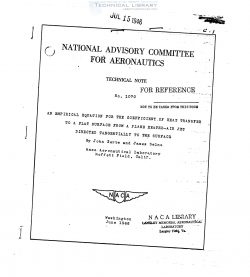naca-tn-1070
- Version
- 163 Downloads
- 553.97 KB File Size
- 1 File Count
- December 2, 2016 Create Date
- December 2, 2016 Last Updated
National Advisory Committee for Aeronautics, Technical Notes - An Empirical Equation for the Coefficient of Heat Transfer to a Flat Surface from a Plane Heated Air Jet Directed Tangentaially to the Surface

An investigation of the heat transfer to a surface from
plane heated—air jets discharged tangentially to the surface—
was conducted to provide heat—transfer relationships required
in the design of heatedvair jet installations for aircraft
windshield fog prevention. '—
Experimental temperature, velocity, and heat—transfer
data were obtained by tests in which the initial jet tem—
perature and velocity Were varied from 101° to 156° F and
from 52 to 218 feet per second, respectivelv. The .jets were
produced by three nozzles of different depths:' namely,
0.102, 0.313, and 0.547 inch.
The resulting data were correlated to yield relation”
ships for the maximum profile Jet velocities and temperatures,
and the coefficients of heat transfer from the jet to the
surface, in terms of the nozzle-exit jet velocity and tem~
perature and of the distance from the apparent Jet origin.
The test results are presented in tabular form and the '
correlations of the data are illustrated graphically.
During an analytical investigation of the use of heated—
air jets to prevent fog formations on the inside surface of
bulletwresisting Windshields. it was found that the required
heatetransfer data were not available; conseuuently; the ' “'"
present investigation on the heat transfer to a surface from "
a plane heated—air jet directed tangentially to the surface
(hereinafter designated as a surface jet) was undertaken.
The rate of transfer of heat from a surface jet to the
surface at a point any distance from the nozzle erit may be
defined as equivalent to the product of a coefficient of heat_
transfer and the difference between the maximum profile tem~
perature in the jet and the temperature of the_surface at
that point. The coefficient of heat transfer is dependent
principally upon the jet velocity and temperature. Equations
establishing the relationship between the jet velocity and
the major jet parameters of unheated surface jets are avail-
able in reference 1 and theoretical temperature relationships
for freely expanding heated jets are available in reference
2. The application of this information to heatedrsurface
jets has not been previously accomplished and there are no
available expressions for the coefficient of heat transfer
for surface jets.
| File | Action |
|---|---|
| naca-tn-1070 An Empirical Equation for the Coefficient of Heat Transfer to a Flat Surface from a Plane Heated Air Jet Directed.pdf | Download |

Comment On This Post